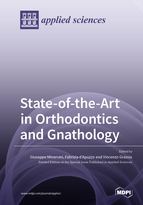State-of-the-Art in Orthodontics and Gnathology
A special issue of Applied Sciences (ISSN 2076-3417). This special issue belongs to the section "Applied Dentistry and Oral Sciences".
Deadline for manuscript submissions: closed (28 February 2022) | Viewed by 15205
Special Issue Editors
Interests: TMJ; Telemedicine; TMD; DTM; temporomandibular disorders; orofacial pain; temporomandibular joint; bruxism; tooth wear; jaw muscle; electromyographic; masseter muscle activity; invisible orthodontic; temporomandibular joint degenerative disorder
Special Issues, Collections and Topics in MDPI journals
Interests: biology of orthodontic tooth movement; vibrational spectroscopies; orofacial pain; temporomandibular joint disorders
Special Issues, Collections and Topics in MDPI journals
Interests: tooth movement; Tads; interdisciplinary approach; clear aligner
Special Issues, Collections and Topics in MDPI journals
Special Issue Information
Dear Colleagues,
In the last few years, new diagnostic and therapeutic approaches have been developed in orthodontics and gnathology, so researchers and clinicians are called to keep up with all the developments that are occurring in this field.
New technologies, as well as digital devices, are available to enhance the effectiveness of the diagnostic process and increase the spectrum of detectable pathologies, dimorphisms, and dysfunctions in the orofacial region. Moreover, new tools such as intraoral scanners, digital models, cone beam computerized tomography, digital smile design (DSD), facial scanning, photogrammetry, and artificial intelligence (AI) have gradually spread, improving diagnoses—especially of impacted teeth, dental transpositions, and dental/orofacial disharmonies.
Furthermore, patients are more careful in terms of treatment time and aesthetics, so techniques such as corticotomy, pulsed light, mechanical vibrations to accelerate orthodontic movement, and clear aligners to obtain an aesthetic treatment approach are being used more frequently.
The aim of this Special Issue is to provide evidence-based data on innovative advances and knowledge in diagnostic and therapeutic technologies in the orofacial field from children to adults.
Studies with innovative approaches or which provide original information are of higher priority.
Papers discussing orthodontic and orthopedic treatments, maxillo-facial surgery, and otolaryngology procedures to manage craniofacial malformations are encouraged, as well as those addressing sleep apnea syndrome treatment.
In this regard, we are delighted to invite investigators to submit original research articles (trials, cohort studies, case–control and cross-sectional studies), high-quality case reports, communication, and reviews (narrative or systematic reviews and meta-analyses) in accordance with the fields previously indicated.
Dr. Giuseppe Minervini
Dr. Fabrizia d'Apuzzo
Dr. Vincenzo Grassia
Guest Editors
Manuscript Submission Information
Manuscripts should be submitted online at www.mdpi.com by registering and logging in to this website. Once you are registered, click here to go to the submission form. Manuscripts can be submitted until the deadline. All submissions that pass pre-check are peer-reviewed. Accepted papers will be published continuously in the journal (as soon as accepted) and will be listed together on the special issue website. Research articles, review articles as well as short communications are invited. For planned papers, a title and short abstract (about 100 words) can be sent to the Editorial Office for announcement on this website.
Submitted manuscripts should not have been published previously, nor be under consideration for publication elsewhere (except conference proceedings papers). All manuscripts are thoroughly refereed through a single-blind peer-review process. A guide for authors and other relevant information for submission of manuscripts is available on the Instructions for Authors page. Applied Sciences is an international peer-reviewed open access semimonthly journal published by MDPI.
Please visit the Instructions for Authors page before submitting a manuscript. The Article Processing Charge (APC) for publication in this open access journal is 2400 CHF (Swiss Francs). Submitted papers should be well formatted and use good English. Authors may use MDPI's English editing service prior to publication or during author revisions.
Keywords
- dentofacial orthopedics
- orthodontic biomechanics
- clear aligners
- temporomandibular disorders
- orofacial pain
- bruxism
- miniscrews
- multidisciplinary treatments
- jaw muscle
- imaging








